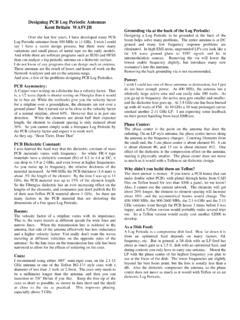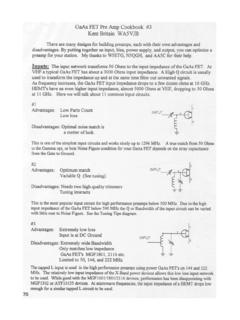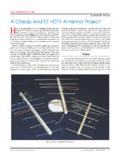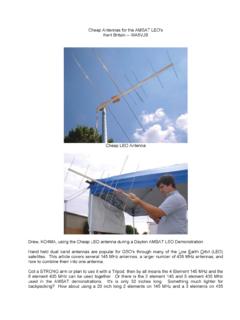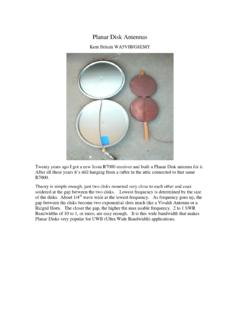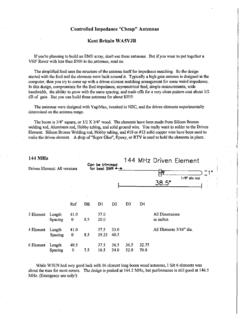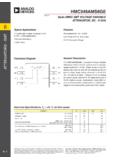Transcription of The Feed is not at the focus of the dish - WA5VJB
1 Antenna Measuring Notes: Kent Britain WA5 VJB (Written for Scatterpoint issue 1-2000 updated Sept 2006) Since 1987 I have set up my portable antenna range at 26 Conferences measuring well over 1500 antennas, mainly in the to 24 GHz range. G4 DDK has asked me to list some of my observations. The Feed is not at the focus of the dish : First off, I have NEVER been able to calculate the focal point of my dish , mount the feed, and have the antenna optimized. NEVER! It always seems I have to move the feed in towards the dish a bit to tweak things up. But out of the antenna range things are far worse. About half of the dishes have the feed off by as much as 50% in distance! A chap comes up with a 2 ft. dish and about a f/d.
2 The feed is sticking out 3 ft from dish ! "But that's where I calculated the focus to be!" is always the answer. I haven't found out what in the D /16c equation throws them, but we see it all the time. Another problem is the rounded edge on most dishes. They measure the physical diameter of the dish , not the diameter of the actual parabolic surface. That outer cm or so of many dishes is not usable and should not be used in the F/d calculations. And I won t even start on the complications of calculating the actual phase center of the feed. I have always been able to pick up a dB or two tweaking the focus and 6 dB or so has been the typical improvement at the conferences when the feed is movable and we can optimize its position.
3 And finally come the 25% or so really bad ones. The " dish " was not parabolic, the feed wasn't resonate in the ham band, the focus was miscalculated by 3 feet (on a 2 ft dish !), using a grid dish on 3cm (and 3cm spacing on the wires), and so on. As I said, typically 25% or so of the dish antennas tested at these conferences are just air cooled dummy loads. Most of these really bad ones are usually the prime focus dishes. With the offset dishes, you usually have a pretty good idea where the feed was for a starting point if you had saved all the parts. But the ham feeds will usually have a different phase center, so we're back to seeing several dB of improvement moving the feed around a few millimeters. The antenna range is also a good spot to figure out where the antenna is pointing.
4 Build up some kind of mechanical sight, or mount a telescopic sight on the edge of the offset dish . (Top edge works well too) Peak up the signal, and sight in on the source. An optical sight can be very useful when portable. On Yagi and Quad loop type antenna, the builder has often used a different diameter boom, or different size elements, or even replaced a round boom with a square boom. In each case there was no attempt to use corrections factors. (50/50 chance they would have gone in the wrong direction anyway!) Again a large percentage of these antennas are not close to what the owners are expecting in the way of performance. If you tested all the microwave antennas in England, I am sure very few of the antennas would have the dB s you have been optimistically using in your range calculations.
5 Interestingly both the UK and ZL groups left the Microwave Update antenna range saying, This antenna measuring is not all that hard and are both looking at setting up antenna ranges back home. Now we will explain how it is not necessarily complicated to set up an antenna range. Equipment: RF Source Source Antenna Reference Antenna Detector Open Space RF Source 1000Hz vs. CW: Many of my first antenna range set-ups as just a CW source, a reference horn, and a power meter. Hold up the power sensor and horn, measure power, attach the antenna to be measured, and the difference in dB power is the difference in dB gain. This works, but you really have some dynamic range problems. The power sensor is not very sensitive, so you have to run a fair amount of power and use a short range.
6 But it does work. Just make sure you have at lease 10 dB more power that the noise floor of the power meter, otherwise you run into (Signal + Noise) / Noise problems. I have been able to make pretty good measurements with 10 to 30 milliwatts sources into 20 dB gain antennas on 6 cm and 3 cm. Horns were measured at about 5 Meters, dish antennas at about 10 Meters from the source. Generating 1000 Hz: I have a Wavetek 3001 500 MHz synthesized signal generator I haul to the antenna range. Most RF generators already have a 1000 Hz AM setting. So up to 500 MHz I just set the generator to max output, 1000 Hz AM and drive a source antenna with it. On 902 MHz, I set the generator to 451 MHz and drive two sides of a mixer, this doubles to 902 MHz which goes through a filter and into a 20 dB gain amp.
7 This gives me about 100 milliwatts to work with. On 1296 MHz I set the generator to 432 MHz, horribly overdrive a small brick amp, filter the 3rd harmonic, and drive a second brick amp. Again, about 100 milliwatts to work with. On 2304 MHz, I set the generator to 384 MHz, again horribly overdrive a small brick amp, filter the 6th harmonic, and drive a second brick amp. This gives me about 75 milliwatts to work with, and there is a second similar unit for 2400 MHz. For 3456 MHz I again use a brick amp (Hand picked this one) driven with 432 MHz and run the 8th harmonic through an interdigital filter. A second brick amp brings this up to 10 milliwatts or so. On GHz, GHz, and , GHz I use Gunn sources driving PIN Diodes.
8 Sometimes I use a 555 timer circuit AA5C built up for me, other times I just drag along a function generator and directly drive the PIN Diodes. On 47 GHz I have a GHz Gunn source driving a doubler out of an old HP 940A. I modulate a PIN diode on the GHz source. So a lot of ways to generate a 1000 Hz modulated RF source. Of course if I had a Signal Generator actually on these frequencies, or even a sweeper with an external modulation input, I would use it. On 80 GHz, my Gunn source has a modulator built into its commercial power supply. Source Antenna You will need an antenna at the source end. It's nice if the antenna has a fair amount of gain and over the years I have used everything from Coffee Can horns, to 2 ft dish antennas on 3 cm.
9 Over the years I have migrated to multiband antennas at the source, just to speed set-up and less stuff to haul about. Ridged horns work well, some the multiband dish feeds work well too. While it is nice for the source antenna to have gain, it is not necessary and I am a firm believer is using what works. More on the type of antenna to use under Open Area. Detectors/terminations At the receiver end we need a simple diode detector to demodulate the 1000Hz AM signal. I normally use a standard Type N Input diode detector. Now, most of these detectors in the US do not contain any kind of terminations. So they don't look like a 50 load, but rather have very complex input impedance. Just put a 6 dB pad on the input of the detector. 10 dB works better, 20 dB has too much loss, and the input is pretty much 50?
10 For the higher bands, the simple diode detector mounted in WG works well. Receiver: If you are using CW and a Power Meter, then this is your receiver. If you are using 1000 Hz, then you need an HP-415, HP416, or the Marconi Type 6593A. Many other companies also make these 1000 Hz "SWR Indicators". These are simply an audio meter tuned to 1000 Hz with a high accuracy meter scale. I have also used General Microwave and NARDA versions of the HP415 and they work just as well. Note: The HP415E needs 9 Volts to run, 16 volts to run in the expanded scale mode. It only pulls about 5 ma, so I will wire in two 9 volt dry cell batteries and can run it for hours and hours on the antenna range. Reference Antenna: The most important part of the antenna range is an antenna you know the gain of The hand of God, or someone with a crayon, has written the gain of the antenna on a calibration sticker, or Post-it-Note.
